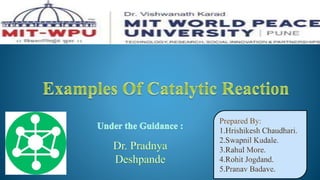Catalytic Reaction
•Download as PPTX, PDF•
0 likes•326 views
Presentation on Examples Of catalytic reaction presented at MIT-WPU.
Report
Share
Report
Share

Recommended
Recommended
More Related Content
What's hot
What's hot (20)
Deactivation and regeneration of catalysts and heterogeneous reaction kinetic...

Deactivation and regeneration of catalysts and heterogeneous reaction kinetic...
Elementary and non elementary reaction(no-18) - copy

Elementary and non elementary reaction(no-18) - copy
Similar to Catalytic Reaction
Similar to Catalytic Reaction (20)
UNIT 8 CHEMICAL KINETICS.pptxUNIT 8 CHEMICAL KINETICS.pptx

UNIT 8 CHEMICAL KINETICS.pptxUNIT 8 CHEMICAL KINETICS.pptx
Recently uploaded
Mehran University Newsletter is a Quarterly Publication from Public Relations OfficeMehran University Newsletter Vol-X, Issue-I, 2024

Mehran University Newsletter Vol-X, Issue-I, 2024Mehran University of Engineering & Technology, Jamshoro
Recently uploaded (20)
On National Teacher Day, meet the 2024-25 Kenan Fellows

On National Teacher Day, meet the 2024-25 Kenan Fellows
Vishram Singh - Textbook of Anatomy Upper Limb and Thorax.. Volume 1 (1).pdf

Vishram Singh - Textbook of Anatomy Upper Limb and Thorax.. Volume 1 (1).pdf
Unit-V; Pricing (Pharma Marketing Management).pptx

Unit-V; Pricing (Pharma Marketing Management).pptx
UGC NET Paper 1 Mathematical Reasoning & Aptitude.pdf

UGC NET Paper 1 Mathematical Reasoning & Aptitude.pdf
Salient Features of India constitution especially power and functions

Salient Features of India constitution especially power and functions
Unit-IV; Professional Sales Representative (PSR).pptx

Unit-IV; Professional Sales Representative (PSR).pptx
Mixin Classes in Odoo 17 How to Extend Models Using Mixin Classes

Mixin Classes in Odoo 17 How to Extend Models Using Mixin Classes
Python Notes for mca i year students osmania university.docx

Python Notes for mca i year students osmania university.docx
Catalytic Reaction
- 2. ? Catalyst is a substance that increases the rate of the reaction at which a chemical system approaches equilibrium , without being substantially consumed in the process. Catalyst affects only the rate of the reaction,i.e.Kinetics. It changes neither the thermodynamics of the reaction nor the equilibrium composition.
- 3. The chemical phenomenon which is influenced by a substance or a set of substances that remains unchanged at the end of the phenomenon is called catalytic reaction. The influencing substances are called catalyst. For example - In Fischer-Tropsch synthesis Ru is used as a catalyst. (2n+1)H2 + n CO + [Ru] = CnH(2n+2) + H2O + [Ru] A catalyst increases the forward reaction as well as backward reaction and reduces the activation energy of a reaction corresponding to the non catalytic reaction of the reactants.
- 4. A)According to the phase of reactant, product and catalyst Catalytic reaction are of 2 types which are as follow : Homogeneous Catalysis: The reactants and catalyst remain in the same phase. For example – In the decomposition of excited NO3* , NO2 is used as catalyst. NO3 *(g) + [NO2(g) ] = NO*(g) + O2 (g) + [NO2(g)]
- 5. Heterogeneous Catalysis : The catalytic process in which the reactants and the catalyst are in different phases is known as heterogeneous catalysis. Some of the examples of heterogeneous catalysis are given below. Oxidation of SO2 to SO3 in the presence of Pt metal or V2O5 as catalyst in the contact process for the manufacture of sulphuric acid. SO2 (g) + O2 (g) + Pt (s) = SO3 (g) + Pt (s) Combination between nitrogen and hydrogen to form ammonia in the presence of finely divided iron in Haber's process. N2 (g) + H2 (g) + Fe (s) = NH3 (g) + Fe (s)
- 6. B). According to the action of catalyst Catalytic reactions are of 4 types which are as follow : Positive Catalytic Reaction Negative Catalytic Reaction Auto Catalytic Reaction. Induced Catalytic Reaction.
- 7. Positive Catalytic Reaction: The typical catalytic reaction on which the rate of the reaction is increased. For example – In the production of Oxygen from Potassium chlorate, Manganese oxide acts as a positive Catalyst. KClO3 + [MnO2] = KCl + O2 + [MnO2] Negative Catalytic Reaction: The catalytic reaction on which the rate of the reaction is decreased. For example – Production of Sodium sulfate from the oxidation of Sodium sulfide solution is hampered by the presence of ethyl alcohol. Na2SO3 + O2 + [C2H5OH] = Na2SO4 + [C2H5OH]
- 8. Auto Catalytic Reaction: In some chemical reactions a component from the products acts as a catalyst i.e. influence the rate of the reaction, such type reactions are called auto catalytic reaction. For example – In acidic oxalic acid solution if we add KMnO4 , the color of KMnO4 disappears slowly but when MnSO4 produced the firstly. KMnO4 + H2C2O4 + H2SO4 = K2SO4 + MnSO4 + CO2 + H2O
- 9. Induced Catalytic Reaction : When a chemical reactions product influences the speed of an other reaction which is not possible under ordinary condition is called as induced catalytic reaction. For example – the following reactions are induced catalytic Reaction. Na3AsO3 + O2 = No Reaction Na2SO3 + O2 = Na2SO4 Na3AsO3 + Na2SO3 + O2 = Na3AsO4 + Na2SO4